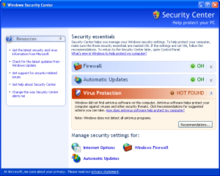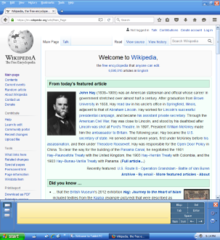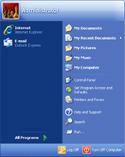
Microsoft occasionally releases service packs for its Windows operating systems to fix problems and add features. Each service pack is a superset of all previous service packs and patches so that only the latest service pack needs to be installed, and also includes new revisions. However if you still have the earliest version of Windows XP on Retail CD (without any service packs included), you will need to install SP1 or SP2, before SP3 can be installed. Older service packs need not be manually removed before application of the most recent one. Windows Update "normally" takes care of automatically removing unnecessary files.
Windows XP was criticized by some users for security vulnerabilities, tight integration of applications such as Internet Explorer 6 andWindows Media Player, and for aspects of its default user interface. Service Pack 2, Service Pack 3, and Internet Explorer 8 addressed some of these concerns.
The service pack details below only apply to the 32-bit editions. Windows XP Professional x64 Edition was based on Windows Server 2003 Service Pack 1 and claimed to be "SP1" in system properties from the initial release. It is updated by the same service packs and hotfixes as the x64 edition of Windows Server 2003.
[edit]Service Pack 1
Service Pack 1 (SP1) for Windows XP was released on September 9, 2002. It contains post-RTM security fixes and hot-fixes, compatibility updates, optional .NET Frameworksupport, enabling technologies for new devices such as Tablet PCs, and a new Windows Messenger 4.7 version. The most notable new features were USB 2.0 support and a Set Program Access and Defaults utility that aimed at hiding various middleware products. Users can control the default application for activities such as web browsing and instant messaging, as well as hide access to some of Microsoft's bundled programs. This utility was first brought into the older Windows 2000 operating system with its Service Pack 3. This Service Pack supported SATA and hard drives that were larger than 137 GB (48-bit LBAsupport) by default. The Microsoft Java Virtual Machine, which was not in the RTM version, appeared in this Service Pack. Support for IPv6 was also introduced in this Service Pack.
On February 3, 2003, Microsoft released Service Pack 1a (SP1a). This release removed Microsoft's Java virtual machine as a result of a lawsuit with Sun Microsystems.
[edit]Service Pack 2
Service Pack 2 (SP2) was released on August 25, 2004, with an emphasis on security. Unlike the previous service pack, SP2 added new functionality to Windows XP, such asWPA encryption compatibility and improved Wi-Fi support (with a wizard utility), a pop-up adblocker for Internet Explorer 6, and partial Bluetooth support. The new welcome screen during the kernel boot removes the subtitles "Professional," "Home Edition" and "Embedded" since Microsoft introduced new Windows XP editions prior to the release of SP2. The green loading bar in Home Edition and the yellow one in Embedded were replaced with the blue bar, seen in Professional and other versions of Windows XP, making the boot-screen of operating systems resemble each other. Colors in other areas, such as Control Panel and the Help and Support tool, remained as before.
Service Pack 2 also added new security enhancements (codenamed "Springboard"),which included a major revision to the included firewall that was renamed to Windows Firewall and became enabled by default, Data Execution Prevention, which can be weakly emulated,[clarification needed] gains hardware support in the NX bit that can stop some forms of buffer overflow attacks. Also raw socketsupport is removed (which supposedly limits the damage done by zombie machines). Additionally, security-related improvements were made to e-mail and web browsing. Windows XP Service Pack 2 includes the Windows Security Center, which provides a general overview of security on the system, including the state of antivirus software, Windows Update, and the new Windows Firewall. Third-party anti-virus and firewall applications can interface with the new Security Center.
[edit]Service Pack 2b
In August 2006, Microsoft released updated installation media for Windows XP SP2 and Windows Server 2003 SP1 to contain a patch that requires ActiveX controls to require manual activation in accordance with a patent held by Eolas.Since then, the technology was licensed by Microsoft, and Service Pack 3 and later versions do not include this update.
[edit]Service Pack 2c
On August 10, 2007, Microsoft announced a minor update to Service Pack 2, called Service Pack 2c (SP2c). The update fixes the issue of the diminishing number of available product keys for Windows XP. This update was only available to system builders from their distributors in Windows XP Professional and Windows XP Professional N operating systems. SP2c was released in September 2007.
[edit]Service Pack 3
Windows XP Service Pack 3 (SP3) was released to manufacturing on April 21, 2008, and to the public via both the Microsoft Download Center and Windows Update on May 6, 2008.
It began being automatically pushed out to Automatic Update users on July 10, 2008. A feature set overview which details new features available separately as stand-alone updates to Windows XP, as well as backported features from Windows Vista, has been posted by Microsoft. A total of 1,174 fixes have been included in SP3.[64] Service Pack 3 can be installed on systems with Internet Explorer versions 6, 7, or 8. Internet Explorer 7 and 8 are not included as part of SP3.
[edit]New features in Service Pack 3
- NX APIs for application developers to enable Data Execution Prevention for their code, independent of system-wide compatibility enforcement settings
- Turns black hole router detection on by default
- Support for SHA-2 signatures in X.509 certificates
- Network Access Protection client
- Group Policy support for IEEE 802.1X authentication for wired network adapters.
- Credential Security Support Provider
- Descriptive Security options in Group Policy/Local Security Policy user interface
- An updated version of the Microsoft Enhanced Cryptographic Provider Module (RSAENH) that is FIPS 140-2 certified (SHA-256, SHA-384 and SHA-512 algorithms)
- Installing without requiring a product key during setup for retail and OEM versions
[edit]Previously released updates
Service Pack 3 also incorporated several previously released key updates for Windows XP, which were not included up to SP2, including:
- Windows Imaging Component
- IPSec Simple Policy Update for simplified creation and maintenance of IPSec filters
- Background Intelligent Transfer Service (BITS) 2.5
- MSXML 6.0 SP2 and XMLLite
- Microsoft Management Console 3.0
- Credential Roaming service (Digital Identity Management Service) update
- Remote Desktop Protocol 6.1
- Peer Name Resolution Protocol 2.1
- Network Diagnostics update
- WPA2 Update (KB893357)
- Windows Script 5.7
- Windows Installer 3.1 v2
- Wireless LAN API (KB918997)
- Improvements made to Windows Management Instrumentation in Windows Vista to reduce the possibility of corruption of the WMI repository.
Slipstreamed retail and OEM versions of Windows XP with SP3 can be installed and run with full functionality for 30 days without a product key, after which time the user will be prompted to enter a valid key and activate the installation. Volume license key (VLK) versions still require entering a product key before beginning installation.
Windows XP Service Pack 3 is a cumulative update of all previous service packs for XP. The service pack installer checksHKLM\SYSTEM\CurrentControlSet\Control\Windows\CSDVersion registry key to see if has a value greater than or equal to 0x100, and if it does it will allow the update to proceed. Otherwise it will prompt to install either XP SP1 or SP2. Since SP1 is no longer available for full download, it would need to be downloaded using Windows Update. The other option is to manually change the registry key, in essence fooling the installer into thinking SP1 is already installed.
However, it is possible to slipstream SP3 into the Windows XP setup files at any service pack level, including the original RTM version, without any errors or issues. Slipstreaming SP3 into Windows XP Media Center Edition 2005 is not supported.
Service Pack 3 contains updates to the operating system components of Windows XP Media Center Edition (MCE) and Windows XP Tablet PC Edition, and security updates for .NET Framework version 1.0, which is included in these Windows XP SKUs. However, it does not include update rollups for the Windows Media Center application in Windows XP MCE 2005. SP3 also omits security updates for Windows Media Player 10, although the player is included in Windows XP MCE 2005. The Address Bar DeskBand on the Taskbar is no longer included due to legal restrictions. It also removed the Energy Star logo from the ScreenSaver tab of the Display properties, leaving a very noticeable blank space next to the link to enter the Power Management control panel.









